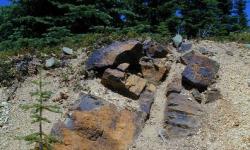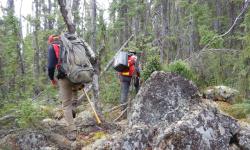Initial Drilling Completed on Titan Copper/Molybdenum Project
British Columbia | October 29, 2004Management of Eagle Plains Resources Ltd. (TSX-V:EPL) and Kobex Resources Ltd. (TSX-V:KBX) announce that diamond drilling has been completed on Eagle Plains’ Titan molybdenum project located 50km west of Atlin in northwestern British Columbia. The property is controlled 100% by EPL (subject to a 1.5% NSR), and consists of 107 claim units covering approximately 6,500 acres. Kobex may earn a 60% interest in the project from EPL by completing $3,000,000 in exploration expenditures, making cash payments of $167,000 and issuing a total of 600,000 voting-class common shares to EPL by the fifth anniversary of signing. EPL was operator of the project in 2004, with operatorship determined on a year-to year basis.
A total of three holes from two sites were completed for a total of 413.6m (1357 feet). The drilling tested Induced Polarization (IP) anomalies defined by 2003 – 2004 surveys completed by Aurora Geosciences Ltd. of Whitehorse, Yukon. The geophysical survey data collection was constrained by poor electrode contacts, particularly in the areas of high grade boulders. Consequently, the geophysical targets tested by drilling are located peripheral to the best observed mineralization. Also, drill collar location is somewhat limited by rockfall hazard associated with steep terrain and retreating ice, which did not allow drill testing in areas of high grade boulders and the Titan showing area.
The results from the drilling indicate that the property is underlain by a mineralized copper – molybdenum porphyry system which also contains disseminated pyrite. DDH T04001 tested a coincident chargeability/resistivity anomaly located approximately 350m west of the Titan showing area. The hole was completed to a depth of 535 feet (163.1m) and intersected granite with local pyrite, chalcopyrite and molybdenite disseminations. The best intercepts were from 89.8 – 90.0m which returned 677ppm molybdenum, and from 151.1 – 152.0m which returned 843ppm copper. Holes T04002 and T04003 were drilled from the same site, approximately 300m north of the Titan showing area. T04002 (380 feet/115.8m) was drilled to the east to test a high chargeability anomaly defined by the IP survey. Drilling intersected a mafic gneiss unit with trace to 0.5% finely disseminated pyrite throughout the hole. The best intersection was a quartz – pyrite shear zone which returned 294ppm Mo, 162ppm Cu, 273ppm Pb, 11.8ppm Ag, 35.5 ppb Au and 1892ppm Bi from 38.9-39.2 meters. Hole T04003 was drilled to the west for 442 feet (134.7m) to test a strong resistivity low defined by the IP survey. The hole collared in mafic gneiss and ended in a granitic unit believed to be equivalent to that intersected in T04001. The best result was from 42.9-43.9 m, where a quartz calcite vein / shear zone returned 1015ppm Mo over a 1 meter interval. Trace disseminated molybdenum and chalcopyrite was noted at the gneiss / granite contact zone from 83.05 – 93.6m, with the best geochemical results associated with a quartz calcite vein at 88.75 – 89.0 m which returned 1551ppm Mo over 0.25 m. Disseminated pyrite and local pyritic veining were noted over the entire hole length.
It is believed that the chargeability anomalies tested in T04001 and T04002 are likely related to disseminated pyrite. The resistivity feature tested by T04003 is likely the contact between the mafic gneiss and the underlying granite. The low grade molybdenum mineralization that was intersected in the drilling does not appear to be the same as that seen at the Titan showing and in the high grade boulder field. Future work will target mineralization exposed in sub-crop near the Titan showing area, interpreted to be the source of the boulders.
Overall project supervision was the responsibility of Charles C. Downie, P.Geo., Exploration Manager of Eagle Plains and identified as a Qualified Person under National Instrument 43-101. Analyses were performed by Acme Analytical Laboratories in Vancouver, BC.
The Titan claim block covers a high-grade molybdenum-copper porphyry occurrence that has been recently exposed by the retreat of glacial ice. 2003 fieldwork by Eagle Plains resulted in the discovery of high-grade molybdenum mineralization in float boulders grading up to 1.877% molybdenum. Outcrop material returned a value of 0.966 % molybdenum in grab samples. Eight of ten rock samples collected returned greater than 0.1% molybdenum. Some samples are also associated with elevated copper (up to 2873 ppm), tungsten (up to 93.1 ppm), and bismuth (up to 60.7 ppm).
Eagle Plains Resources continues to conduct research, acquisition and exploration projects in western Canada. The Company controls over 30 gold and base-metal projects, many of which are currently optioned to or joint-ventured with third parties including NovaGold Inc., Kobex Resources Ltd., Northern Continental Resources Inc., Shoshone Silver Mining Co., and Golden Cariboo Resources Inc. These agreements expose Eagle Plains to over $18 million in exploration expenditures over the next five years. In recent years, Eagle Plains has completed option agreements with Billiton Metals, Rio Algom Exploration, Kennecott Exploration, Viceroy Resource Corp. and numerous other junior exploration companies, resulting in over 18,000m (60,000 ft) of drilling and over $6,000,000 in exploration spending on its projects since 1998.
On behalf of the Board of Directors
Signed
“Tim J. Termuende”
President and CEO
For further information on EPL, please contact Mike Labach at 1 866 HUNT ORE (486 8673)
Email: mgl@eagleplains.com or visit our website at http://www.eagleplains.com
Cautionary Note Regarding Forward-Looking Statements
Neither the TSX Venture Exchange nor its Regulation Services Provider (as that term is defined in the policies of the TSX Venture Exchange) accepts responsibility for the adequacy or accuracy of this release. This news release may contain forward-looking statements including but not limited to comments regarding the timing and content of upcoming work programs, geological interpretations, receipt of property titles, potential mineral recovery processes, etc. Forward-looking statements address future events and conditions and therefore, involve inherent risks and uncertainties. Actual results may differ materially from those currently anticipated in such statements.
Latest News Releases

Eagle Plains Partner Earthwise Completes Data Review of the Iron Range Gold Project, British Columbia

Eagle Plains and Sun Summit Minerals Execute Option Agreement for the Theory Copper-Gold Project, British Columbia

Eagle Plains and Earthwise Minerals Execute Option Agreement for the Iron Range Gold Project, British Columbia

Eagle Plains and Partner Refined Energy Receive Permit for Drilling at Dufferin West Uranium Property, Saskatchewan

Eagle Plains Announces Letter of Intent with Earthwise Minerals for Option of the Iron Range Project, British Columbia

